Custom WordPress development offers businesses a powerful way to differentiate themselves in a crowded digital space. It allows businesses to create a unique online presence tailored to their goals and target audience. Unlike generic WordPress templates, custom WordPress websites offer enhanced functionality, search engine optimization (SEO), and a seamless user experience. The customization options within WordPress development help businesses meet technical requirements like fast load times, mobile device compatibility, and advanced features such as custom WordPress themes and plugins.
At Aloa, we deliver high-quality custom WordPress development projects through a robust development process. Our development team has extensive experience using the latest industry trends. We work with WordPress developers to ensure every custom WordPress site has an optimized WordPress design, WordPress theme, and website design that reflects your brand. Our team focuses on providing scalable, efficient WordPress website development solutions tailored to your specific web development needs.
Grounded in our industry expertise, this guide explores custom WordPress development. We'll walk you through the WordPress website's design options, technical requirements, and customization options. By the end of this blog, you’ll understand the WordPress community and how to create the perfect custom WordPress website for your business.
Let's dive in!
What Is Custom WordPress Development?
Custom WordPress development is building custom websites with unique themes, WordPress plugins, and features tailored to a client’s specific needs. Unlike default templates, custom development ensures that websites align with a brand’s identity and goals. It focuses on creating a unique user experience, optimized performance, and scalability.
Core Components of Custom WordPress Development
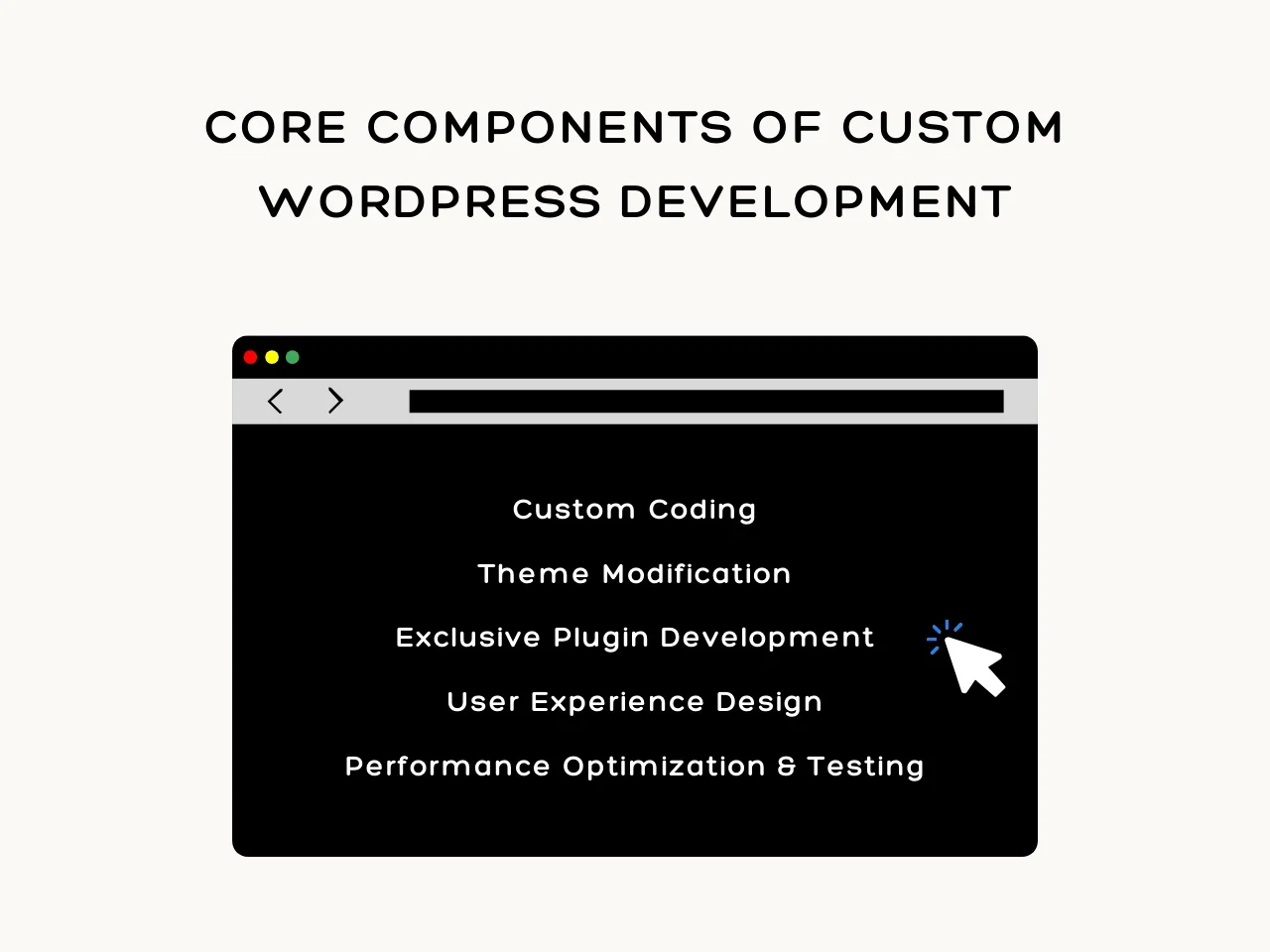
- Custom Coding: Developers use languages like PHP, HTML, and CSS to write unique code for custom sites, providing full control over the website’s layout and functionality.
- Theme Modification: Web designers personalize the homepage, URL, and overall web design by modifying default WordPress themes to tailor the site’s look to the client’s brand.
- Exclusive Plugin Development: Developers create unique WordPress plugins to add functionalities specific to the client’s business, seamlessly integrating with the website to enhance performance.
- User Experience Design: A web design company focuses on creating user-friendly interfaces to improve browser visibility, internet performance, and mobile accessibility.
- Performance Optimization and Testing: Custom WordPress development prioritizes performance with optimized JavaScript and server configurations. Regular testing ensures high scalability and compatibility with all browsers.
This process involves a dedicated web designer and developer team focusing on clear milestones and project timelines. Their primary objective is to deliver a fully functional website. Proper web design ensures seamless social media integration, boosting online presence and business growth.
Advantages of Custom WordPress Solutions Over Generic Options
Custom WordPress development gives businesses powerful tools to create websites that stand out. Unlike generic options, custom solutions allow for tailored functionality, better branding, and optimized performance. Let's explore five key advantages of custom WordPress development over off-the-shelf themes and plugins.
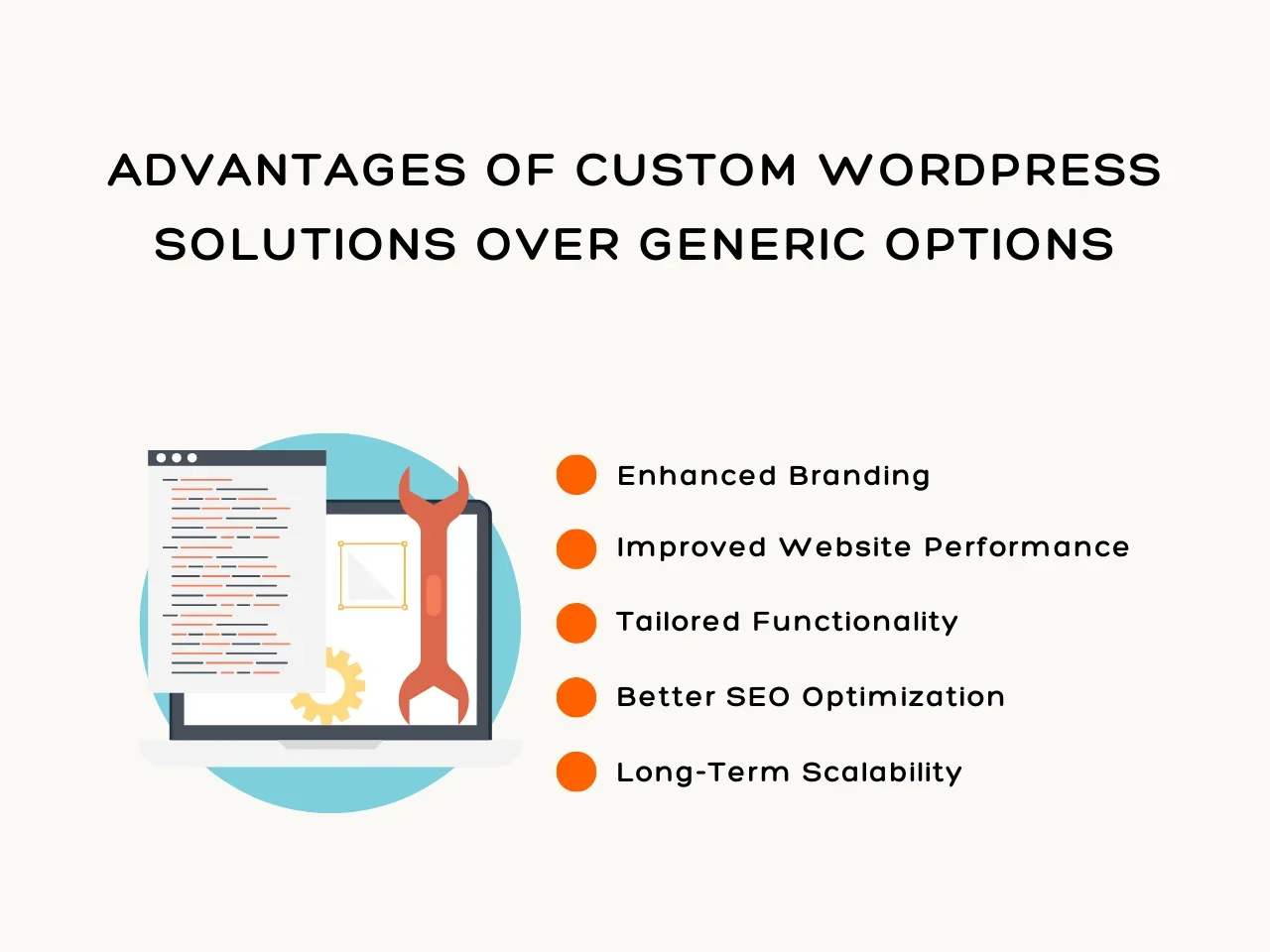
1. Enhanced Branding
Custom WordPress development allows businesses to reflect their brand's identity through unique website designs. Instead of relying on generic themes, custom WordPress website design ensures every site element aligns with the company’s image. This enhances brand recognition and offers a memorable user experience.
2. Improved Website Performance
Custom WordPress website development focuses on optimizing the website for speed and performance. Developers create lightweight code and streamline the site, ensuring faster load times. They can also implement smart integrations to connect Elementor forms to Monday, automating workflows and maintaining optimal site performance. As a result, custom WordPress websites perform better, contributing to lower bounce rates and improved search engine rankings.
3. Tailored Functionality
Custom WordPress solutions offer the freedom to develop specific functionalities that address business needs. Whether you need a custom e-commerce platform, membership site, or specialized booking system, custom WordPress development allows complete flexibility. Pre-built themes cannot match this level of customization.
4. Better SEO Optimization
Custom WordPress website development enables developers to integrate SEO best practices. A well-structured website built through custom development ranks higher on search engines. This improves visibility and helps attract more organic traffic compared to generic WordPress themes, which may lack SEO customization options.
5. Long-Term Scalability
Custom WordPress websites provide scalability as your business grows. Developers design websites to accommodate future expansions, ensuring the site can handle increased traffic and more complex features over time. Pre-built themes often have limitations, making scaling difficult, while custom development ensures long-term success.
Understanding the Custom WordPress Development Process
Custom WordPress development involves creating a website tailored to your needs and business goals. This process ensures your site stands out with unique design, functionality, and performance. Below are the four key steps to achieving a successful custom WordPress website.
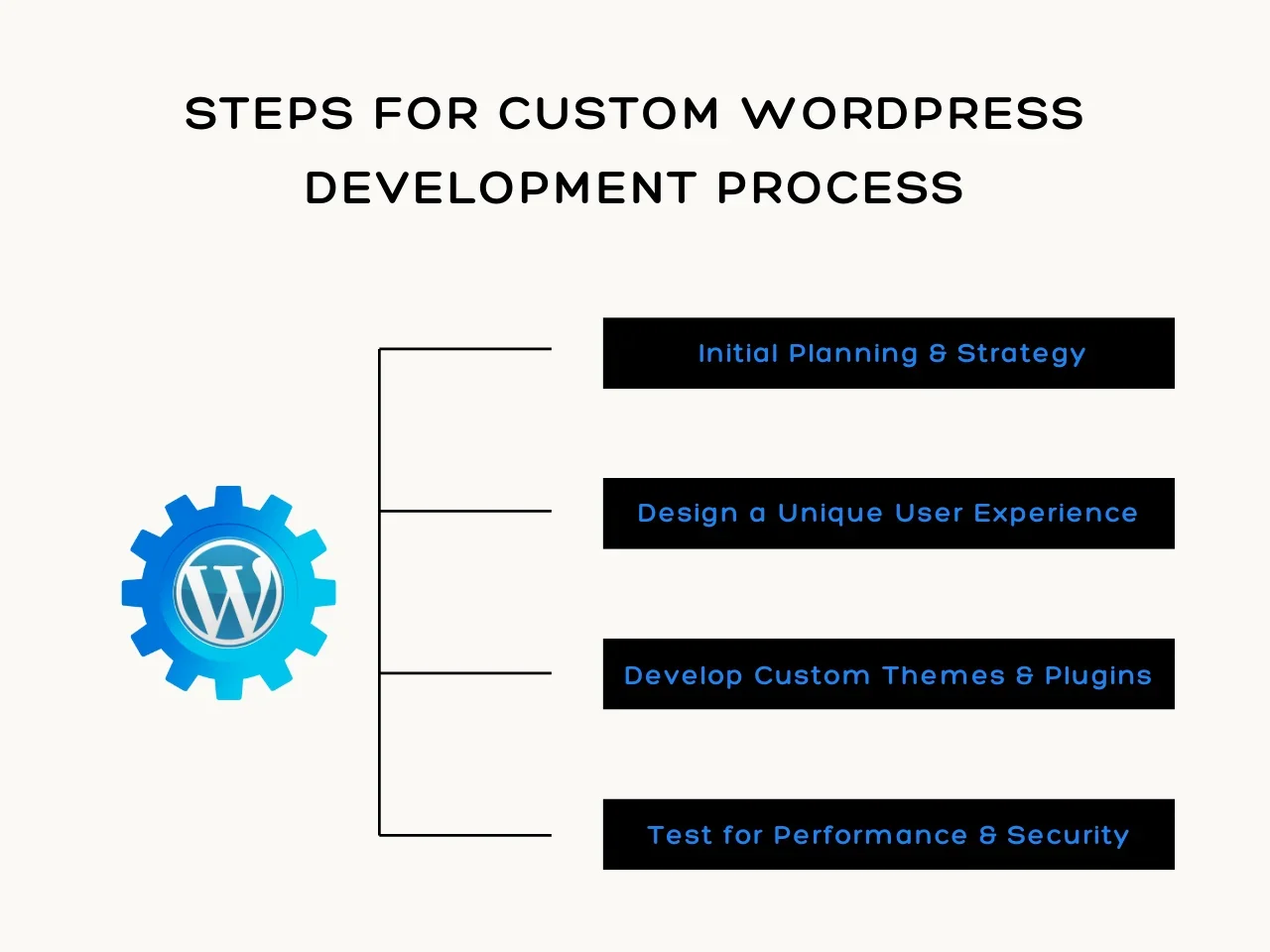
Step 1: Initial Planning and Strategy
The custom WordPress development process begins with thorough initial planning and strategy. During this phase, the developer works closely with the client to understand the project goals and desired functionality. The technical requirements and the overall vision for the site are discussed to ensure everyone is aligned. This planning phase is crucial for avoiding issues down the road and for delivering a product that meets client expectations.
Some essential questions to consider during the initial planning phase include:
- What is the primary purpose of the website?Understanding the core objective helps define the design and functionality.
- Who is the target audience?Knowing who will use the site informs the content and user experience.
- What features are essential? Identifying must-have features guides the technical aspects and backend work.
- What is the budget?Budget considerations will impact the scope and design.
- What is the timeline?Knowing the deadline ensures that development stays on track.
These questions help establish clear objectives and allow for a tailored development strategy. Proper planning streamlines the development process and ensures the final product meets both technical needs and business goals. This stage lays the groundwork for a successful WordPress website.
Step 2: Design a Unique User Experience (UX)
A well-thought-out design enhances navigation and ensures users can interact with the website effortlessly. During this phase, you consider how users will flow through your website and make adjustments that lead to a smooth, intuitive experience. These are the steps involved in creating a user-centric design that aligns with brand identity and user needs:

- Understand the Target Audience: Identify your target users' preferences, behaviors, and pain points to tailor the design.
- Create a Site Map: A clear structure makes navigating between pages easier without frustration.
- Use Wireframes: Simple wireframes outline where key elements will sit on each page, offering a visual guide.
- Incorporate Brand Colors and Fonts: These should reflect the brand’s identity, ensuring the website maintains consistency with other materials.
- Test Usability: Conduct usability tests to gather feedback and refine the experience for better performance before launching.
A strong user experience improves satisfaction and encourages return visits. The goal is to ensure that every user feels connected to the brand while quickly finding the information they need.
Step 3: Develop Custom Themes and Plugins
Developing custom themes and plugins is a key part of custom WordPress development. It allows you to tailor your website to meet your needs, ensuring your online presence stands out. The process begins after thoroughly understanding the client's requirements and goals. Custom themes give your website a unique design, while plugins add the desired features to improve functionality.
When developing custom themes, the technical steps involved include:
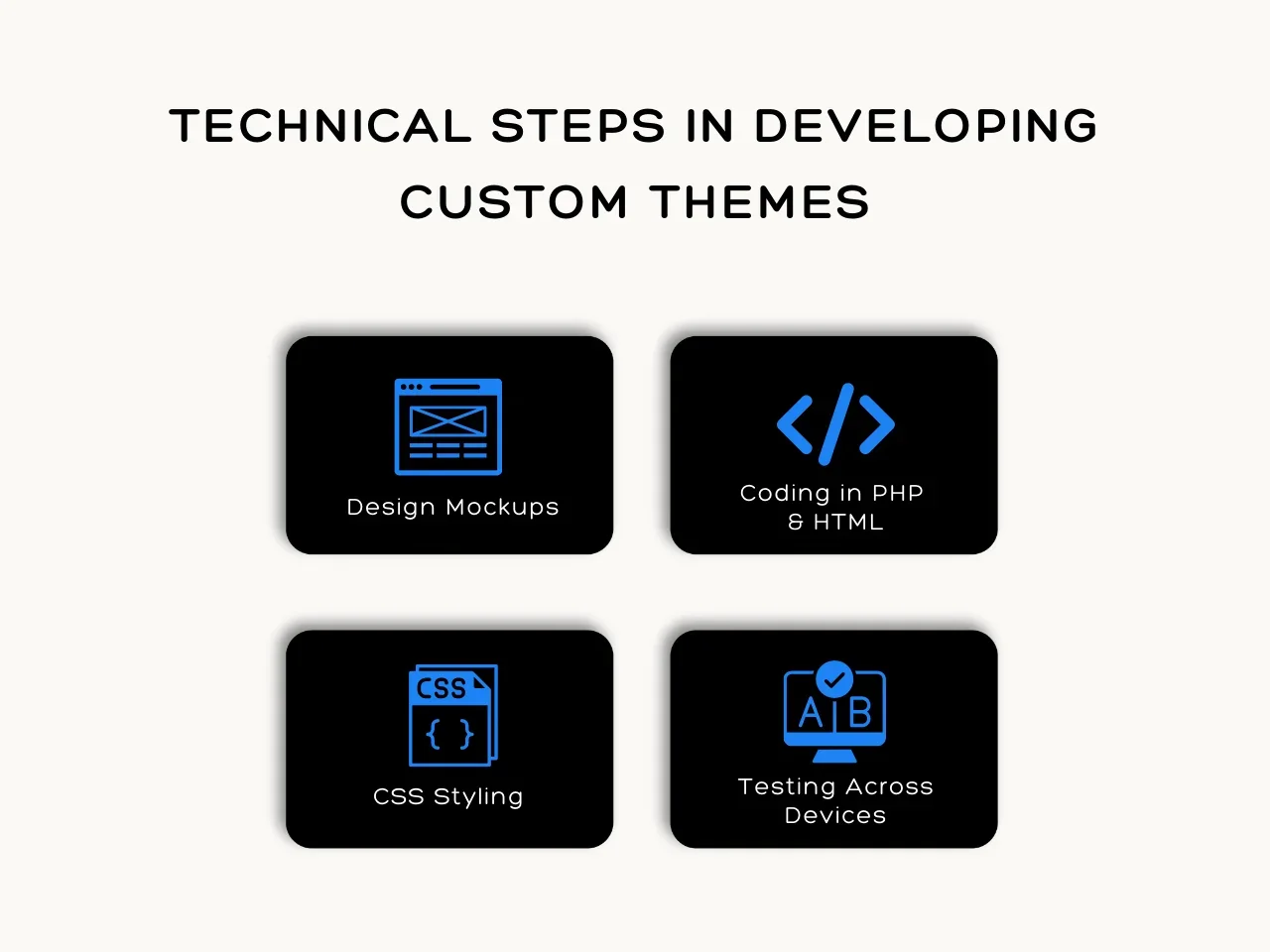
- Design Mockups: Create visual layouts that match the brand’s look and feel. These mockups serve as blueprints for the development phase.
- Coding in PHP and HTML: Use these languages to build the theme's structure, ensuring it's dynamic and responsive across devices.
- CSS Styling: Apply CSS to bring the design to life with the right colors, fonts, and layouts, keeping the website visually appealing.
- Testing Across Devices: Test the theme on different browsers and devices to ensure compatibility and a seamless user experience.
The plugin development process involves identifying specific functions that the client needs. This could range from custom forms to advanced search features. Each plugin is coded and tested to ensure it works perfectly within the theme, enhancing the user experience.
Step 4: Test for Performance and Security
Performance and security testing are essential to ensure your custom WordPress site operates smoothly and is protected from threats. This step guarantees the website's seamless user experience and safeguards sensitive data. Performance testing helps optimize loading times, while security testing ensures vulnerabilities are addressed before the site goes live.
Critical aspects of performance and security testing include:
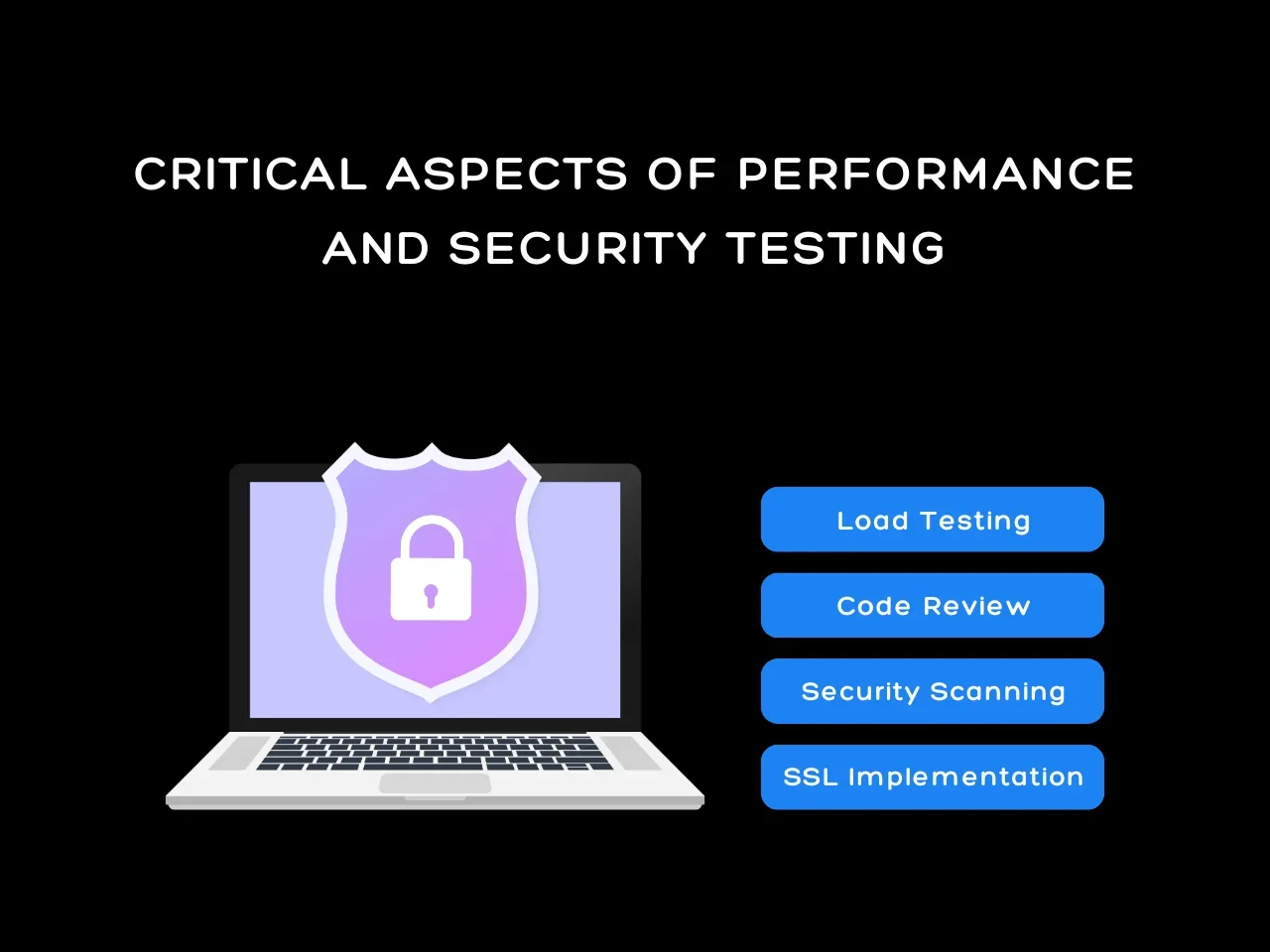
- Load Testing: Simulate heavy traffic on the site to check how it handles multiple users simultaneously. This helps identify potential slowdowns and server issues.
- Code Review: Review the website's code to spot inefficiencies and ensure it runs efficiently without unnecessary delays.
- Security Scanning: Run security scans to detect any vulnerabilities, such as weak passwords or exposed files, and fix them immediately.
- SSL Implementation: Ensure an SSL certificate is installed correctly. This certificate encrypts user data and adds trust indicators like the padlock icon in browsers.
Performance and security testing isn’t a one-time process. Continuous monitoring helps maintain high standards, ensuring the website adapts to changes while remaining fast and secure. These tests are crucial for maintaining long-term success and user satisfaction.
Key Differences Between Custom and Pre-built WordPress Solutions
Businesses must understand the key differences between custom WordPress development and pre-built WordPress solutions. These differences impact website performance, scalability, and long-term investment. Here’s a detailed comparison to help you choose the best fit for your business needs.
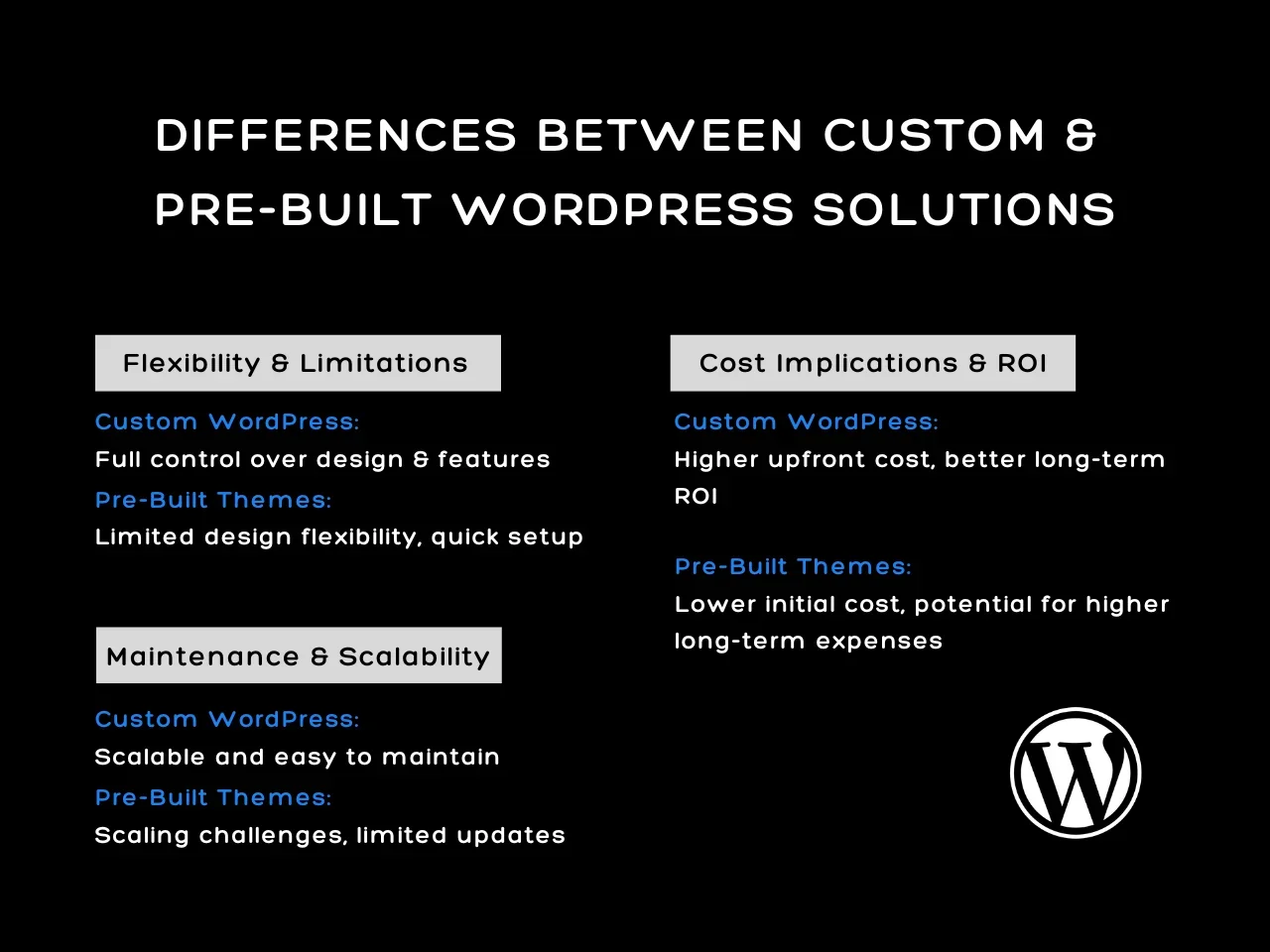
1. Flexibility and Limitations in Design and Functionality
Regarding flexibility, custom WordPress development and pre-built WordPress themes offer vastly different capabilities. While custom development empowers businesses with complete control, pre-built themes can impose limitations that affect long-term functionality.
- Custom WordPress Development: Custom solutions provide full control over design and functionality. Businesses can tailor their websites to match their branding, add unique features, and create a user experience aligned with their goals.
- Pre-built WordPress Themes: Pre-built themes often limit design and feature flexibility. While they offer a quick setup, they restrict customization options, hindering a company’s ability to stand out or meet evolving business needs.
Custom WordPress development stands out in terms of flexibility and functionality. It allows businesses to adapt and evolve, ensuring their website serves user experience and business objectives. Pre-built themes may be quicker to deploy, but their limited design options often result in a lack of distinction and growth potential.
2. Long-Term Maintenance and Scalability
Long-term maintenance and scalability are critical for choosing between custom WordPress development and pre-built themes. As business needs evolve, the ability to update and expand a website without hindrance is essential.
- Custom WordPress Development: Custom websites ensure long-term scalability and are easier to maintain. Developers build them with future growth in mind, seamlessly updating and adding new features.
- Pre-built WordPress Themes: Pre-built themes can present challenges in scaling and maintenance. Compatibility issues may arise during updates, and limited functionality may slow down site improvements as business requirements evolve.
Custom WordPress development ensures seamless scalability and ongoing maintenance, allowing businesses to grow without limitations. Pre-built themes, while easy to launch initially, often need help to keep up with a growing company's demands, leading to issues in performance and functionality down the road.
3. Cost Implications and Return on Investment
Cost and return on investment (ROI) are significant when choosing between custom WordPress development and pre-built themes. While pre-built solutions may seem cost-effective upfront, the long-term benefits of custom development often outweigh the initial expense.
- Custom WordPress Development: Though the upfront cost is higher, custom development offers better long-term ROI. Businesses benefit from optimized performance, enhanced SEO, and a website designed to grow alongside their operations.
- Pre-built WordPress Themes: Pre-built solutions have lower initial costs but can lead to higher expenses. Limited scalability, lower performance, and frequent updates often incur additional costs.
Custom WordPress development offers superior long-term value and a more substantial return on investment, despite requiring a higher initial investment. On the contrary, pre-built themes may appear cost-effective initially, but their limitations often increase costs as businesses seek to maintain and scale their websites.
Key Takeaway
Custom WordPress development provides businesses unmatched flexibility, enabling them to create websites tailored to their unique needs. This approach allows companies to integrate custom features, streamline functionality, and design websites that reflect their brand identity. With tools like Gutenberg, Visual Composer, and Elementor, custom development becomes even more adaptable, ensuring that websites meet the latest trends and user preferences.
Custom-built sites optimize loading times, improve user experience, and boost SEO rankings, helping businesses compete more effectively digitally. These custom solutions scale quickly, allowing companies to grow and evolve without limitations.
Is your business ready for a custom WordPress development solution? At Aloa, we offer the expertise, industry insights, and comprehensive project management framework needed to create the ideal custom WordPress website for your business.

